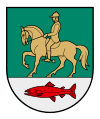Priekulė, Lithuania
| Priekulė | |||
|---|---|---|---|
| City | |||
|
Main street toward Klaipėda | |||
| |||
 Priekulė Location of Priekulė | |||
| Coordinates: 55°33′20″N 21°19′10″E / 55.55556°N 21.31944°ECoordinates: 55°33′20″N 21°19′10″E / 55.55556°N 21.31944°E | |||
| Country |
| ||
| Ethnographic region | Lithuania Minor | ||
| County |
| ||
| Municipality | Klaipėda district municipality | ||
| Eldership | Priekulė eldership | ||
| Capital of | Priekulė eldership | ||
| First mentioned | 16th century | ||
| Granted city rights | 1948 | ||
| Population (2005) | |||
| • Total | 1,690 | ||
| Time zone | EET (UTC+2) | ||
| • Summer (DST) | EEST (UTC+3) | ||
Priekulė (![]() pronunciation , German: Prökuls) is a small city in Klaipėda district municipality, Lithuania. It is located in the former curonian landscape Lamotina on the banks of Minija River about 20 km south of Klaipėda. Priekulė is the seat of Priekulė elderate. Priekulė was part of East Prussia for most of its history and became part of Lithuania from 1923–1938 and after World War II in 1945.
pronunciation , German: Prökuls) is a small city in Klaipėda district municipality, Lithuania. It is located in the former curonian landscape Lamotina on the banks of Minija River about 20 km south of Klaipėda. Priekulė is the seat of Priekulė elderate. Priekulė was part of East Prussia for most of its history and became part of Lithuania from 1923–1938 and after World War II in 1945.
Name
The curonian-Latvian name describes a market place: "preks": price; "prece": merchandise (see also pr.-lit. "prekius": to offer, to haggle). The ending -uls/ -ol is a diminutive and shows that this place was not of great importance.
History
Priekulė's name is known since the first half of the 16th century. At first it was named Paminia (at river Minia), and it was a small village with three homesteads. 1511 is a tavern "zur Minnige" testified. 1540 is a certain Lukas Preckol owner of the tavern. The name "Precols" was recorded on region maps in 1548. A church was built in 1587 and a teacher was hired in 1594.
In 1609 during the Polish–Swedish War (1600–1611), regiments of the Polish–Lithuanian cavalry plundered the town. In 1688 minister Wilhelm Martin built a new church. In 1905 the village, now known as Prökuls, had 500 residents who were mostly Protestant Lutherans and mainly spoke the Memelland-Samogitian dialect. Before World War II around 1,200 people lived in Priekulė among them very few ethnic Germans.
On December 19, 2002 the city was granted coat of arms by the President of Lithuania.
Landmarks
There is St. Anthony of Padua Church, built in 1938. In the city park grows a centuries-old oak, that is preserved as monument of nature. In the city there is a monument to Lithuanian writer Ieva Simonaitytė. Her cottage is turned into memorial museum (established in 1984). Estates of the forefathers of philosopher Immanuel Kant (1724–1804) were located in Kantweinen in the vicinity of Priekulė.
Notable residents
- Egon Erzum (1904-1974), German politician
- Erich Hippke (1888-1969), German physician and Generaloberstabsarzt in the Luftwaffe
Literature
- Mortensen, Hans und Gertrud: Kants väterliche Ahnen und ihre Umwelt, Rede von 1952 in Jahrbuch der Albertus-Universität zu Königsberg / Pr., Holzner- Verlag Kitzingen/ Main 1953 Bd. 3
- Sembritzki, Johannes: Geschichte des Kreises Memel, Memel 1918
| Wikimedia Commons has media related to Priekulė. |
- This article incorporates text translated from Memeler Dampfboot (German Magazine for people from Memelland, mostly refugees living in Germany) and family history
.gif)

